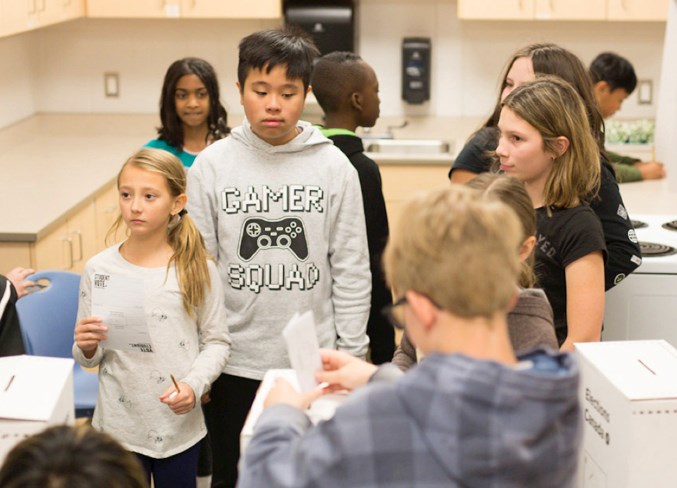Holy Trinity Catholic School students who voted for federal candidates as part of the Student Vote program voted a bit differently than their adult counterparts in the Red Deer-Mountain View riding, and a lot differently than their fellow students across the country.
About 110 Holy Trinity students from grades 4 to 6 were "voluntold" to participate, says Grade 6 teacher Darcy Ledrew, who coordinated the project. They voted on Oct. 18. The federal election was held Oct. 21.
Ledrew says 32.4 per cent of Holy Trinity students voted for incumbent Earl Dreeshen of the Conservative Party and 26.9 per cent for People's Party of Canada candidate Paul Mitchell. Logan Garbanewski of the New Democratic Party (NDP) received 17.6 per cent of the votes. Conner Borle of the Green Party obtained 13.9 per cent, and Gary Tremblay of the Liberal party finished last with 9.3 per cent.
Ledrew figures Mitchell did so well in the vote because he had a lot of lawn signs in Olds.
"I think his ability to have signs everywhere, I think that got his name in everybody's mind," he said.
More than 1.1 million elementary and secondary school students participated in Student Vote Canada 2019.
In the Student Vote program nationally, the Liberal Party obtained 22.3 per cent of the popular vote and won 110 seats, forming a minority government.
The NDP formed the official Opposition with 24.8 per cent of the popular vote and 99 seats.
The Conservative Party took 25.1 per cent of the popular vote and won 94 seats.
The Green Party obtained 18.2 per cent of the popular vote and won 28 seats.
The Bloc Québecois took 1.3 per cent of the popular vote and won nine seats.
In the real election, the Liberals obtained 157 seats, down from 184 in 2015 and didn’t win any seats in Alberta or Saskatchewan. They received 33.06 per cent of the popular vote. The Conservative Party won 121 seats, up from the 99 four years ago and received 34.4 per cent of the vote.
The New Democratic Party (NDP) obtained 24 seats, down from 44 in the 2015 election, but won a seat in Edmonton.
The Bloc Quebecois won 32 seats, up from 10 in 2015.
The Green Party obtained three seats, up from two.
The People's Party did not win any seats. Its leader, Maxime Bernier, who quit the Conservative Party to form the People's Party, lost his seat.
Grade 6 students Zoe Boyd and Andrew Murray were among those who voted in the program at Holy Trinity school.
"I thought having a chance to vote, but not in the real election was really cool because I never really knew how it was like in the real election so I just had a chance to do it," Boyd said.
Boyd was asked if she put a lot of thought into who she voted for.
"Not really," she said with a laugh. "I didn't know who the parties were."
She said she watched election coverage on the news after she voted, but not before.
Boyd said there were no issues that stood out for her.
Murray said it was "really easy" for him to decide who to vote for.
"I've never voted before so I just decided just to pick a random person who, like, was the nicest out of all of them. There was one nice one. The other ones just were — rude."
Murray said he wasn't impressed by Green Party Leader Elizabeth May's plan to prevent people from buying fossil-fuel-propelled vehicles and to ensure all cars in Canada are electric in 11 years.
"When she said to get rid of fossil fuels for like, cars and stuff, I didn't really want to vote for her because she said electric cars. But you have to strip mine to get the stuff for electric cars and it just wrecks the earth, so she wasn't really helping," he said. "And no one likes Trudeau — not too much people."
Murray said his uncle is in the oil and gas industry so that was a factor in his vote.
Boyd and Murray were asked if they plan to vote once they turn 18. They both said that depends on whether there's a leader or candidate they believe in.



